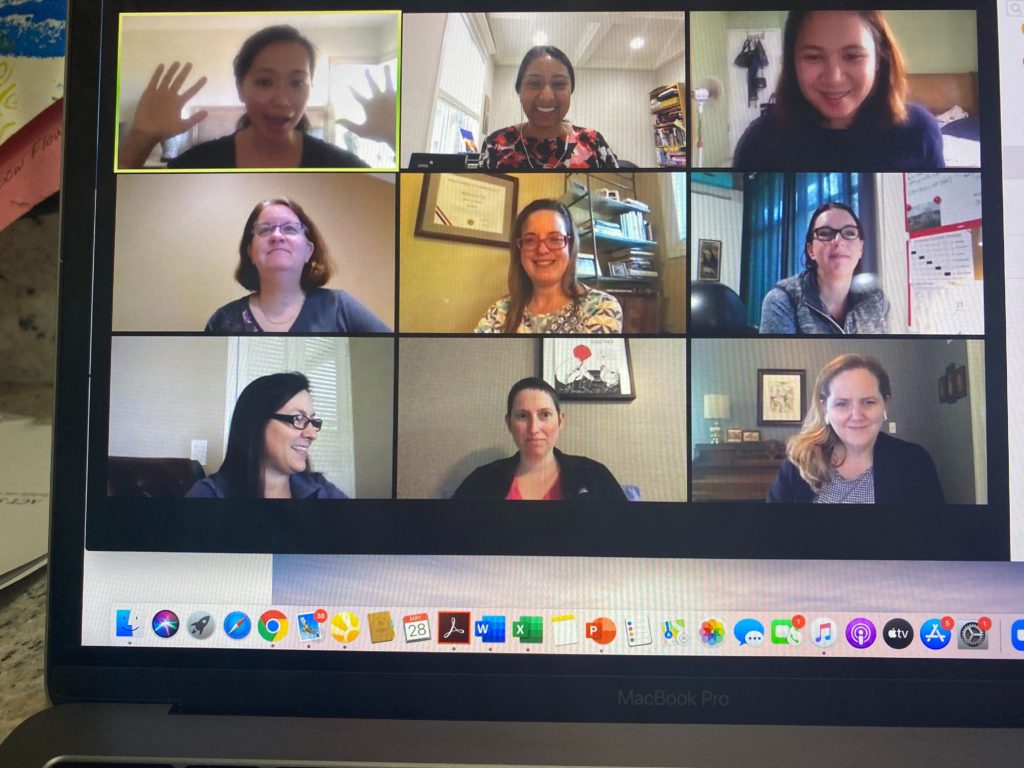December 18, 2020 / Esther Choy

Storytelling revolutionizes team building by changing interaction patterns.
One of the many repercussions of the pandemic is the way it has destabilized workplace culture.
“In a situation like this, everybody is in their little bubbles,” Cynthia Wang, a clinical professor of management and organizations at Kellogg School of Management, told Kellogg Insight recently, “and it’s hard to actually reinforce the shared values and goals of people within the company.”
She adds, “Over time, those ties that bind are starting to unravel.”
Wang recommends that leaders not only check in with each team member formally and frequently, but also that they foster informal ways for team members to bond with each other. After all, there’s no more water cooler conversations, no quick jaunts to the corner coffee shop, no drinks after work.
Leaders have to be intentional about building corporate community right now. But does a typical corporate off-site do the trick?
Why Typical Corporate Off-sites Fail
A standard corporate off-site checks these boxes:
- Providing business updates
- Team building through having fun
- Team building through learning together
Nothing wrong with any of these. But the problem is that too often corporate leaders think the team has been built up at their latest off-site when, in fact, the ground has not even been cleared for the foundations of team building.
It’s vital to keep front and center the reasons why team building is important in business. Team building must forge new bonds of trust and spark new ideas for collaboration. To create space for this to happen, leaders must break new ground. They have to get people to disrupt their typical interaction patterns.
Every relationship falls into conversation patterns—especially our relationships with co-workers. Perhaps we’re task-driven and it feels more efficient to put conversation patterns on autopilot. Or maybe we’re afraid to risk revealing too much (or prying!) for fear of straining relationships with people we hope to work with for years to come.
These unexamined patterns strangle workplace interactions. An off-site is the perfect time to break the stranglehold. Leaders can’t check the “team building” box unless we’ve helped our teams do this.
But now the question is… how?
Business storytelling lets teams hone a vital skill while also disrupting unproductive conversation patterns. That’s why leadership storytelling revolutionizes team building.
How Does Storytelling Help Build Corporate Culture?
“Business storytelling training” might conjure images of everyone hunched over their individual workspace, writing a story. Or, we might imagine a lecturer at the front of the room explaining what business storytelling is all about.
In reality, a good business storytelling training tasks people with gathering stories from each other. As a wise storyteller once said, “To be a great storyteller, you must first become a great story collector.” And through this story-gathering, we begin to learn more about our colleagues.
“Why Does She Do That?”
We often assume we know plenty about who our colleagues are, especially if we’ve worked with them for a long time. But what we don’t often know is why they are the way they are—or why they hold the beliefs they hold. This is a neglected aspect of team relationships.
As teams share their stories, we can discover more about what has shaped them.
For instance, at a Leadership Story Lab storytelling training, a participant named Mary Johnson shared a story about how a full, detailed binder was her most prized possession whenever she planned for travel. Her attention to detail in preparing her travel plans is the same attention she brings to her work every day.
Johnson’s hiring manager was in the same training and said, “That is exactly why we hired her. It just took us days of interviews to figure that out. You got to the essence of it in 20 mins!”
Another time when a group worked through the same exercise, one person mentioned that even though she had worked and actually sat next to her colleague for seven years, she still learned many meaningful new things by asking him story-prompting questions.
Effective team building activities can reveal the essence of people’s character. Understanding and trusting each other’s character strengthens workplace relationships and facilitates collaboration.
Choose Your Challenge
Storytelling revolutionizes team building because it lets people choose their own challenge. As important as it is to get to know each other at an off-site, no one wants to feel like they’re being forced to share way-too-personal stories.
As my firm has led business storytelling training sessions at off-sites, we’ve found it extremely helpful to let people choose from a list of about 20 story-prompting questions. We’ve crafted questions that let people choose a comfortable level of transparency—whatever that means for them.
One good question, for example, is, “What was something you believed to be right for a long time, and then discovered that it’s wrong or have changed your mind?”
Someone could choose to answer, “I used to be a coffee snob.” That’s somewhat personal, but it’s hardly a revelation about sleepless nights grappling with one’s beliefs.
On the other hand, someone could take more risk—as we watched one participant do at an admissions event. When asked about changing beliefs, this man answered, “I used to think Obamacare was garbage.”
He unpacked how he came to change his mind. The company he worked for had acquired several healthcare companies, which meant he had to study healthcare in the United States. Really study it. As he learned more, he realized Obamacare was not entirely without merit! This divulges quite a bit more about his beliefs. In fact, it even takes the risk of speaking on a politically divisive issue. It’s a risk he chose to take, and it allowed him to connect more deeply with many of his peers.
What are the best team building activities for work?
The best team building activities for work are team driven rather than exercise induced. This is another reason leadership storytelling revolutionizes team building
When a team focuses on collecting each other’s stories, they can decide what direction to take, rather than following an exercise meant to induce vulnerability. Through story collecting, a conversation arises. Each person decides what story to share based on their comfort level with the people they’re talking to. Instead of taking risks to meet the demands of an exercise, people will naturally take risks to support each other.

Once again, the types of questions shape the team dynamics. The person who was willing to share his views on Obamacare told me that at other team building events he’s attended, the questions have been canned, like: “What’s your greatest achievement?”
Better questions yield more authentic responses that create stronger bonds between colleagues.
Believe it or not, there are a few party games that are excellent sources of questions that let the team shape their own dynamics without resorting to regurgitating their accomplishments. For instance, the game Table Topics is designed to encourage engaging conversations with unexpected questions like, “Which historical sporting event would you like to witness?” and “If you were the mayor of your city what would you change?”
Another question-based game, called Actually Curious, is specifically focused on building empathy through “the science and psychology of emotional connection,” as the game’s website explains. What’s especially valuable about this simple card deck is that questions are color-coded for four levels of depth. For instance, the first level includes questions that would be easy to ask a stranger to answer. The final level, however, includes questions people may have avoided asking even their closest friends.
For a game designed to inspire storytelling, try Story Cubes, which requires players to connect the unconnected with a story.
The devil’s in the details here. It’s not difficult to imagine how storytelling helps your team bond and cultivate corporate culture. But the way you go about facilitating storytelling at your team’s off-site makes all the difference in the world.
If you don’t have an off-site coming up, you can still find ways to seek out stories from everyone in your organization every day. And as a leader, it’s imperative! Here’s how to do it.
Related Articles
Better Conversations Start With 3 Listening Skills from StoryCorps
Discover Someone’s Character In 20 Minutes
Better Every Story
"This is an amazing and insightful post! I hadn’t thought of that so you broadened my perspective. I always appreciate your insight!" - Dan B.
Join the thousands who receive Esther Choy’s insights, best practices and examples of great storytelling in our twice monthly newsletter.



